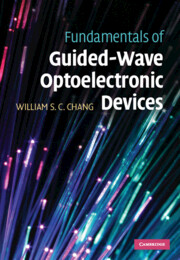2 - Guided-wave interactions
Published online by Cambridge University Press: 25 January 2011
Summary
The operation of many photonic devices is based on interactions between optical guided waves. We have discussed the electromagnetic analysis of the modes in individual planar and channel waveguides in Chapter 1. From that discussion, it is clear that solving Maxwell's equations rigorously for several coupled modes or waveguides is very difficult. Only approximate and numerical solutions are available. In this chapter, we will introduce several approximate electromagnetic techniques for analyzing the interactions of guided waves. These methods include the perturbation method and coupled mode analyses. Practical devices such as the grating filter, the directional coupler, the Y-branch coupler, the Mach–Zehnder modulator, and the multimode interference coupler will be discussed as specific examples. In addition, analysis of coupled waveguides as super modes of the total structure in the effective index approximation is presented. This analysis will allow us to view the interactions between coupled waveguides from another point of view.
In Chapter 1, we have shown that the guided-wave modes together with the radiation modes comprise a complete set of modes. In guided-wave devices, radiation modes are excited at any dielectric discontinuity. Rigorous modal analysis of propagation in a waveguide with varying cross-section in the direction of propagation should involve, in principle, all the modes. However, radiation modes usually fade away at some reasonable distance from the discontinuity. They are important only when radiation loss must be accounted for.
- Type
- Chapter
- Information
- Fundamentals of Guided-Wave Optoelectronic Devices , pp. 39 - 68Publisher: Cambridge University PressPrint publication year: 2009



